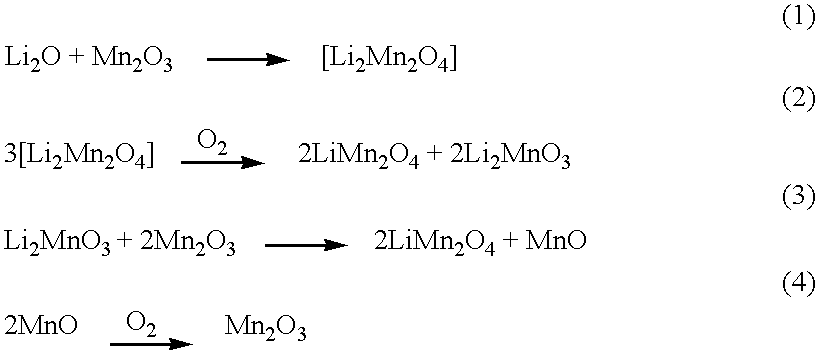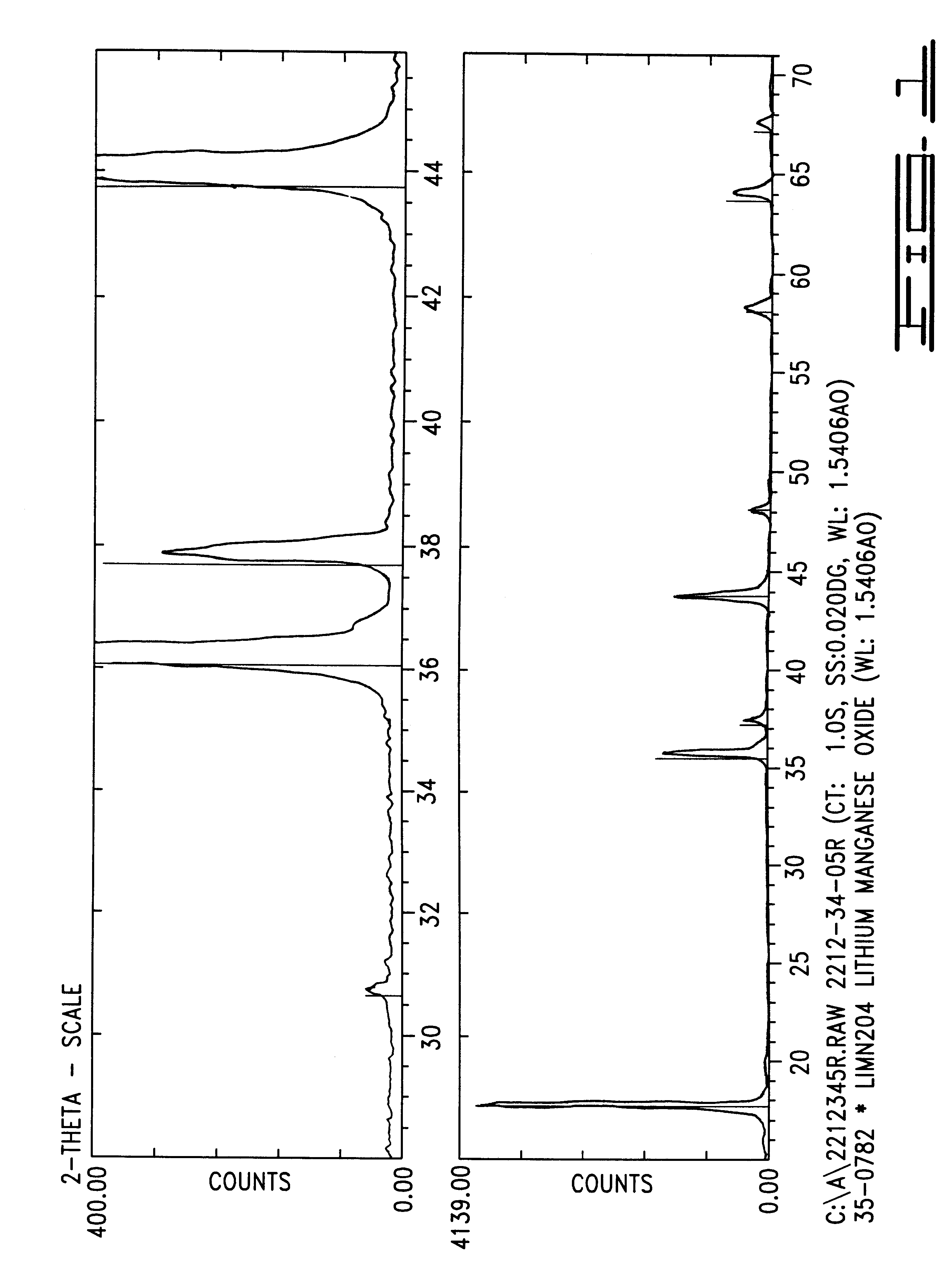Cathode intercalation compositions, production methods and rechargeable lithium batteries containing the same
a technology of cathode intercalation and composition, which is applied in the direction of non-aqueous electrolyte cells, cell components, electrochemical generators, etc., can solve the problems of rapid capacity fade, less than satisfactory performance, and unsatisfactory for today's stringent requirements
- Summary
- Abstract
- Description
- Claims
- Application Information
AI Technical Summary
Benefits of technology
Problems solved by technology
Method used
Image
Examples
example 1
Stoichiometric LiMn.sub.2 O.sub.4 was prepared by first intimately mixing 2,000 grams of Mn.sub.2 O.sub.3 with 462.9 grams of Li.sub.2 CO.sub.3. The reaction mixture was ramped at 2.degree. C. per minute to 750.degree. C. and calcined at that temperature for 16.67 hours in a box furnace under flowing air at 2 standard cubic feet per hour. The partially reacted mass was cooled to room temperature, remixed with little reduction of particle size, reheated and recalcined as before. Final cooling was at 0.9.degree. C. per minute to ambient temperature. The stoichiometric LiMn.sub.2 O.sub.4 produced was tested for initial capacity, capacity fade rate and lattice constant. The results of these tests are set forth in Table IV below.
The standard semi-commercial lithium manganese oxide compositions of Table I as well as the stoichiometric LiMn.sub.2 O.sub.4 produced in Example 1 above along with the test compositions produced in the various examples which follow are set forth in Table IV belo...
example 2
100 grams of stoichiometric LiMn.sub.2 O.sub.4 having an average particle size of 25 microns was blended with 1.62 grams of powdered LiOH.H.sub.2 O and 0.28 grams of .alpha.-Al.sub.2 O.sub.3 having submicron particle size. The mixture was heated at 1.degree. C. per minute to 500.degree. C. for a 6 hour soak. The mixture was then further ramped at 1.degree. C. per minute to 750.degree. C. and calcined at that temperature for 16.67 hours in a box furnace under flowing air at 2 standard cubic feet per hour. The partially reacted mass was cooled to room temperature, remixed with little reduction of particle size, reheated and recalcined for an additional 16.67 hours. The product, Li.sub.1.046 Al.sub.0.02 Mn.sub.1.934 O.sub.4 was cooled at 0.9.degree. C. per minute to ambient temperature. The product was tested as described in Example 1 and also for tap density and surface area, the results of which are shown in Table IV below.
Previous work with LiOH.H.sub.2 O indicates that this salt, a...
example 3
50 grams of Mn.sub.2 O.sub.3, 11.94 grams of Li.sub.2 CO.sub.3 and 1.51 grams of submicron size TiO.sub.2 where mixed and heated at 1.degree. C. per minute to 750.degree. C. under air flowing at 2 standard cubic feet per minute. After 16.67 hours of reaction, the product was cooled, remixed, ramped at 2.degree. C. per minute to 750.degree. C. and calcined for another 16.67 hours. Final cooling was at 0.9.degree. C. per minute to ambient. The produced product was nominal Li.sub.1.007 Mn.sub.1.933 Ti.sub.0.06 O.sub.4. Analysis of the x-ray defraction pattern showed a large lattice constant (8.252 .ANG.) and a Mn.sub.3 O.sub.4 impurity, both known indicators of poor capacity fade characteristics. The product was not cycle tested.
PUM
 Login to View More
Login to View More Abstract
Description
Claims
Application Information
 Login to View More
Login to View More - R&D
- Intellectual Property
- Life Sciences
- Materials
- Tech Scout
- Unparalleled Data Quality
- Higher Quality Content
- 60% Fewer Hallucinations
Browse by: Latest US Patents, China's latest patents, Technical Efficacy Thesaurus, Application Domain, Technology Topic, Popular Technical Reports.
© 2025 PatSnap. All rights reserved.Legal|Privacy policy|Modern Slavery Act Transparency Statement|Sitemap|About US| Contact US: help@patsnap.com



